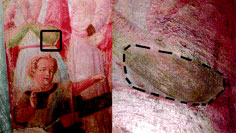| Posted: May 14, 2007 |
Nanotechnology to restore Renaissance wall paintings |
|
(Nanowerk News) Back in October 2006 we ran a Nanowerk Spotlight on how "Nanotechnology saves Renaissance masterpieces, Mayan wall paintings, and old shipwrecks"
|
|
Professor Piero Baglioni, the scientist from the University of Florence whom we covered in this article, has just published a new paper titled "Oil-in-Water Nanocontainers as Low Environmental Impact Cleaning Tools for Works of Art: Two Case Studies".
|
 |
|
In the new study, Baglioni and his colleagues show that acrylic polymers usually employed in works of art (or architecture) conservation and highly insoluble inorganic deposits containing organic materials can be solubilized in an oil-in-water microemulsions from nonionic surfactants and that a complete cleaning of an acrylic-contaminated painting can be successfully achieved.
|
|
The researchers note that their emulsion is particularly efficient for the cleaning of a secco painting, a fragile painting difficult to clean with “conventional” methods. They also formulated an additional emulsion for the specific and very demanding removal of salts and asphaltenes.
|
|
Baglioni concludes that the excellent results obtained in the “real cases” (e.g. a wall paint by Vecchietta in Santa Maria della Scala Sagristy, Siena, Italy) suggests that these new oil-in-water nanocompartimentalized systems can be adopted in the near future for conservation of cultural heritage, achieving, at the same time, the possibility of using a methodology with very low environmental impact and high performance for the cleaning of painted surfaces.
|

